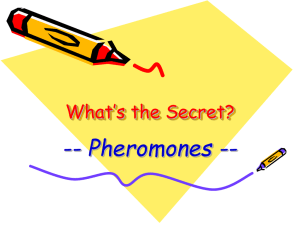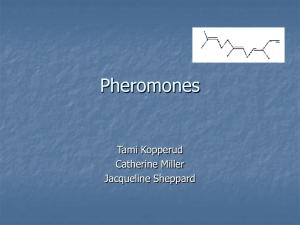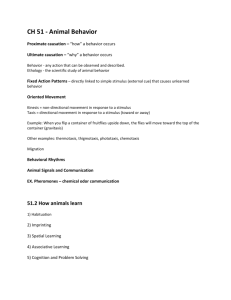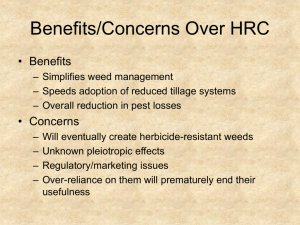A STUDY OF THE PREVALENCE ... IN THE DORlYiITORIES OF BALL ...
advertisement
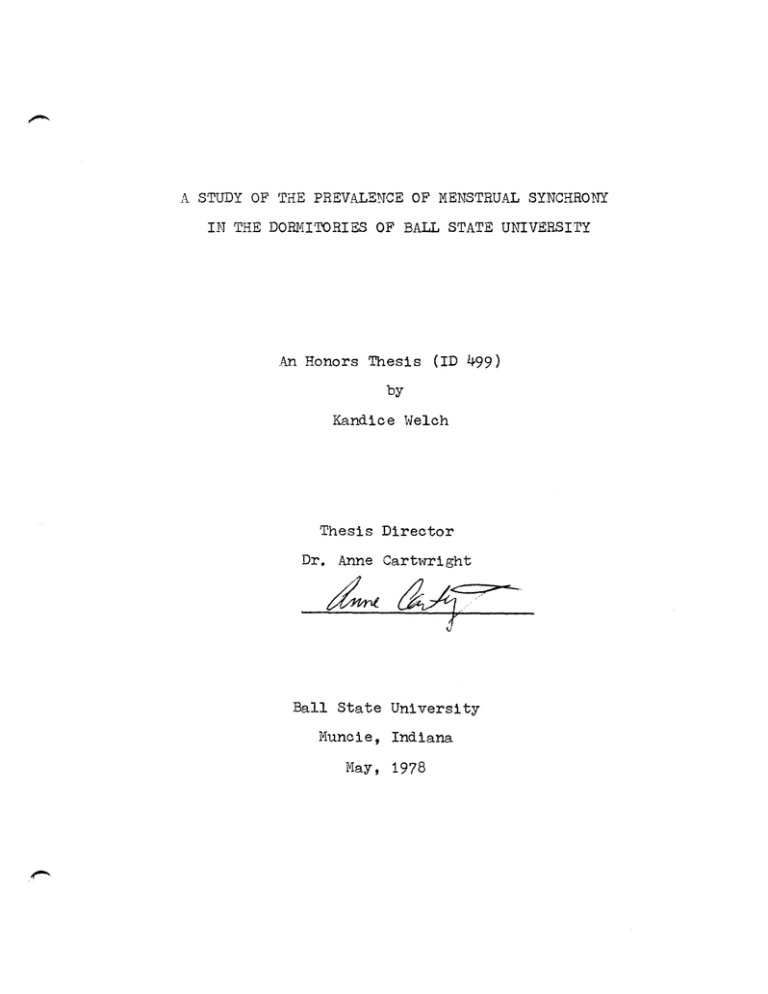
A STUDY OF THE PREVALENCE OF MENSTRUAL SYNCHRONY
IN THE DORlYiITORIES OF BALL STATE U1TIVERSIry
An Honors Thesis (ID 499)
by
Kandice Welch
Thesis Director
Dr. Anne Cartwright
Ball State University
Muncie, Indiana
May, 1978
Sf(.c \1
·1\\eSI~>
L .')
:.t1lti
. -z.!t
11'6
\I
\,\)1./5,'),
ACKNOWLEDGEMENTS
The author wishes to express her appreciation for
her thesis director, Dr. Anne Cartwright, for the valuable,
but sometimes frustrating learning experience of writing an
acceptable scientific paper.
I would also like to thank the teachers Nho allowed
me to canvas their classes for volunteers, and the subjects
themselves wi thout
~Thom
there would be no paper.
The author
"t'Tould like to acknowledge Dr. McComish for the use of his
calculator.
Special thanks are in order for my indispensable
husband, Mike.
ii
TABLE OF CONTENTS
Page
ACKNOWLEDGEMENTS • • •
LIST OF APPE~IDICES
.. .. ..
. . . . .. .. . . . . . .
ii
iv
CHAPTER
I.
• •
..
III. MATERIALS AND METHODS . . . . . . . . . .
RESULTS AND DISCUSSION • . .
IV.
...
CONCLUSIONS . .
.....
V. SUMMARY
LITERATURE CITED • • • • • • • • • . . . . . . . .
II.
-
INTRODUCTION.........
REVIEW OF RELATED LITERATURE •
A~ID
iii
1
2
14
17
22
23
LIST OF APPENDICES
Page
1.
· ·· ·
Packet of forms used in study •
··• • ·• ··
Ba clc ground information on control subjects
·• ·
25
4.
Background information on experimental
35
5.
First day of menses for control subjects,
August through April •
•
•
•
2.
3.
6.
-
Ball State University assurance and certification of revie't'j of a single project involving
human subjects
• •
•
•
•
7.
8.
····· ···
subjel~ts
·· · · ···• • •
First day of menses for experimental subjects,
August through April
·• • ···• • ···• • ·
Differences between onset of menses for subject pairs • •
····• ··• • ··• • ·• • •
t-test results
······• ·····• • • • ·
iv
28
34
36
37
38
39
INTRODUCTION
The purpose of this study was to determine l'rhether
a relationship existed betw"een two ';'mmen rooming together
in a Ball State University dormitory and the timing of
their menstrual cycles.
NcClintock (1971) condu.cted a
similar study in an eastern all women college and found
that within a period of four monthes the time of menses for
roommates and close friends began to synchronize.
The
present study differed from that of McClintock i,n that the
basic environnent was a co-educational instituti.on.
-
Similar reproductive phenomenona to that observed
by HcClintock have been observed among other mammals, and
the causes are believed to be pheromonal in nature.
Pheromones are odors which carry messages from one individual to another.
The 'ltvord itself is derived from the Greek
pherein, to transfer; hormon, to excite.
There is much
current speculation on the possible role of pheromones in
both nonhuman and human primate behavior.
REVIEW OF THE RELATED LITERATURE
Karlson and Luscher (1959:55) defined pheromones as
"substances which are secreted to the outside by an individual and received by a second individual of the same
species, in which they release a specific reaction, for
example, a definite behaviour or a developmental process."
Law and Regnier (1971) in their review article su'bdi vided
pheromones into two divisions; releasers and prim1ers.
Releasers had an immediate effect on the behavior of the
recipient whereas primers had a delayed effect.
'rhese
definitions were originally applied to insect pheromones.
Pheromones were first discovered in 1896 when it was
found that live female moths in cardboard traps could be
used to attract male moths (Comfort, 1972).
Sinee that
time many different insect pheromones l'fi th many different
functions have been identified.
Law and Regnier (1971)
cited examples of recruitment pheromones to increase
foraging efficiency and alarm pheromones which sig;naled
flight or aggression both of which were found in social
insects.
The sting apparatus of bees contained alarm
pheromones which induced other bees to sting at the same
location.
omones.
Ants were also often attracted by alarm pherThe queen honeybee secreted a pheromone 'I'1'hich
prevented the development of worker ovaries.
3
The majority of the studies on insect pheromones
concentrated on those compounds vThich were responsible for
sexual attraction.
Many compounds which have the same
attractive effect have been synthesized, and they may prove
vA.luable in controlling harmful insects.
Since pheromones
are interspecific they do not have the broad spectrum effect
of most insecticides which destroy both the useful as well
as the harmful insects (Comfort, 1972).
At this time pheromones have not proven to be
feasible in controlling heavy insect infestations; how"ever,
they have been useful in the control of light infestations.
Pheromones have also been useful as an assay tool for
measuring the size of insect populations, and the communication disruption effect of pheromones has been studied as a
possible method of regulating population growth.
Communica-
tion disruption consisted of spraying large doses of the
male attractant pheromone over infested areas during the
breeding season in order to confuse the males in their
attempts to find the true females (Marx, 1973).
The effect of olfactory stimuli such as the attraction
of males to estrous females, have been observed in mammals
for centuries.
However, it was not until the early 1950's
when olfactory influence on the reproductive
cyclE~s
of
laboratory mice were observed that mammalian pheromones
attracted serious scientific interest.
Lee and Boot (1956) found that when female mice were
grouped together in the absence of a male, many of the mice
4
became anestrous.
These mice also exhibited a high rate of
pseudopregnancies.
Lee and
.~
suspected that the stimulus
was olfactory in nature, for neither phenomenon oecurred
among mice in which the olfactory bulb had been removed.
A few years after the discovery of what is now known
as the Lee-Boot effect, Whitten (1959) found that grouped
anestrous female mice would come into estrous when exposed
to a male mouse or his urine.
Furthermore, if all of the
mice were exposed to this stimulus at the same time, the
presence of the male served to synchronize their estrous
cycles.
A third pheromonal effect on the reproductj.ve process in mice was discovered by Bruce (1959).
When pregnant
females were exposed to an unfamiliar male or his urine
they reabsorbed their developing fetuses.
The sexual maturation of mice may also be tnfluenced by pheromones.
Drict~mer
(1977) discovered that the
first estrous of young female mice was delayed by exposure
to either grouped females or their urine.
Physical contact
and social interaction with grouped females produeed no more
delay in the sexual maturation of the young than did
exposure to the urine of the grouped females
alonE~.
Another study discovered that there was an andr6gendependent urinary pheromone in male mice which aceelerated
sexual maturation in young females (Lombardi, 197(,).
-
This
pheromone appeared to be suppressed in both juvenile and
adult males when they were placed in a
subordinatE~
social
5
-
role to a . more dominant male.
Production of this pheromone
may be suppressed by the presence of pregnant or lactating
females.
Lombardi suggested that in high density populations
the intense male-male interactions and the presence of pregnant and lactating females may have partially accounted for
suppressed fertility in populations where males are abundant.
Pheromones may have played a role in developing
mother-young bonds in some rodents.
r101 tz and LE~idahl
(1977)
suggested that in lactating female rats the prolactin in
some manner altered the composition of the bile.
This
alteration effected the chemistry of the cecum of the rat
which resulted in production of a maternal pheromone.
pheromone was secreted with the female's feces.
receiving injections of bile taken from
lactatine~
This
After
female
rats, males were also able to release this young··attractant
pheromone.
Doty (1976) reviewed several studies which
indicated that pheromones may have played a role in the
nursing activity, ,nest location, and clumping behavior of
rodent young.
Doty (1976) cited many other examples of the role of
pheromones in non-primate mammalian behavior, both among
domestic and feral animal populations.
Many
un~llates
had special scent gland which were used to mark off territory.
Odor might also have been important in the identifica-
tion of offspring by many female ungulates.
male pigs
~vas
The presence of
able to hasten sexual development in prepubertal
6
females although it has hot been shmm whether the stimulus
~ras
olfactory in nature.
There
TTaS
also data that the pre-
sence of a ram was able to induce synchronized estrous in
female sheep and that this stimulus was at least partially
olfactory (Morgan et
al., 1972).
Michael and Keverne (1968) :round that anosmic male
rhesus monkeys could not distinguish between attractive
estrogenized females and unatrracti ve ovariectomi.zed females.
Later (1970) these authors discovered that the previously
unattractive oVariectomized females could be made attractive
to normal ma,les when their genital areas were pai.nted with
the washings from the vagin3.s of estrogenized females.
They
postulated that there were attractive chemicals ln the
vaginal secretions of the estrogenized females
~.J'hich
stim-
ulated both male interest and overt male sexual behavior
(mounting and ejaculation) even though the
ovariE~ctomized
female l.;as not aroused and i'.J'as not giving the appropriate
behavioral cues.
Keverne and
~1ichael
chemicals "copulins."
(1970) called these hypothesized
Copulins were isolated from female
monkeys in 1971 (Michael et
a1., 1971).
They proved to be
short chain aliphatic acids and were tentatively identified
as acetic, propionic, isobutyric, isovaleric, and isocaprioc
aCids.
In tests with four males these aliphatic acids, when
separated from the vaginal secretions and applied to
oVariectomized females, caused a substantial increase in
overt male sexual behavior.
7
The question still remains unanswered of how large
a part learning plays
Goldfoot, et
in these reproductive behaviors.
a1. (1978) attempted to repeat l\1ichael's exp-
eriments using sexually experienced males which he made
anosmic.
Their monkeys continued to exhibit normal sexual
interest and behavior over a course of several reproductive
cycles.
They (Goldfoot et, al., 1978:1096) concluded that
"Detection by the male of olfactory cues from the female
is not a .. necessary condition either for the occurance or for
the cyclicity of copulatory behavior of the pair over a
course of several ovulatory cycles."
The role of pheromones in primate olfaction is not
limited to sexual attraction and reproduction.
Kaplan and
Russell (1974) studied the role of olfaction in the development of social attachment in the young squirrel' monkey.
~Vhen
young monkeys were given choices between their own
surrogate mother and its associated smells, clean surrogates,
and surrogates of other young monkeys they definitely preferred their own.
In contrast, when given the choice
between surrogates of the same color as their surrogate or
different colors, their response varied from one session
to another with no definitive preference.
The authors con-
cluded that at an early age squirrel monkeys are m,ore
responsive to odors than to visual stimuli.
They also felt
that a greater dependence on olfaction for identification
-..
of the mother may have evolved from the fact that the infants
8
-
were carried on their mothers' backs (their eyes and noses
buried in their mothers' coats).
Comfort (1971:432) listed a number of facts which
would support the possibility of the existance of pheromones
in man:
(1) Pheromonal primer effects are nearuniversal in social mammals, including primates.
(2) Releaser pheromone effects exist in
man, at least in larval forms, and some involve
pheromones of other mammals (musk, civetone) •••
(3) In mammals as against insects,
functional and species specificity do not seem
to depend on a multiplicity of special substances. Cross-specific reactions are common
(humans react to musk; bulls, goats, and monkeys to the odour of women) •.• The physiological
effect of similar molecules is likely to be
similar between man and other mammals •••
(4) Humans have a complete set of organs
which are traditionally described as nonfunctional, but which, if seen in any other
mammal, would be recognized as part of a pheromonal system. These include apocrine glands
associated"with conspicuous hair tufts, some of
which do not produce sweat and must presumably
produce some other functioning secretion, a developed prepuce and labia, and the production of
smegma.
One approach to determining the role of pheromones in
human behavior involved the study of odor thresholds for
various compounds.
Attempts were made to discover whether
there was a sex difference in odor perception and whether the
odor threshold changed in relationship to the menstrual cycle
and pregnancy.
Doty (1976) reviewed many of these experi-
ments, but found that different studies gave conflicting and
puzzling results.
In a study conducted with 24 European couples, Hold
and Schleid t (1977) found that these couples could distin-.·
9
between personal odors.
The subjects wore clean .cotton
undershirts for seven nights in a row.
They were then given
three opportunities to identify their own and their mate's
shirts from a group of ten shirts.
They were also required
to lable each shirt as male or female and to rate its odor
as pleasant, indifferent or unpleasant.
The results showed that 31 percent of the subjects
were able to identify their own odor, and 33 perc,ent could
identify the shirts of their partners; 46 percent incorrectly
identified a stranger's shirt as their partner's or their
own, while 18 percent could not distinguish between the
shirts.
The female subjects gave more correct responses
than the males.
Another interesting outcome was that
neither length of marriage nor sleeping arrangements seemed
to influence the number of correct responses.
Hold and Schleidt found that the couples associated
specific emotional attributes with the odors.
Most of the
subjects ranked the odor of their mate's shirt as pleasant.
Of the subjects 32 percent were able to correctly identify
male and female odors.
Both sexes more often labled female
odors as pleasant and male odors as unpleasant.
'rhe majority
of the males were indifferent to their own odor whereas the
majority of the women ranked their own odor as pleasant.
As
a result of this study, Hold and Schleidt felt that human
odor played an important role in non-verbal communication.
Russell (1976) conducted a similar study using college
students and the undershirts that they had worn for 24 hours.
10
-
Of his subjects 75 percent were able to correctly identify
their own shirt from among three undershirts.
Thl9 subjects
were also able to correctly identify the two remaining shirts
as either male or female with 75 percent accuracy,.
No data
were taken as to the relative pleasantness or unpleasantness
of the odors.
Russell (1976;52) stated that the tests
show that "at least the rudimentary communications of sexual
discrimination and individual identification can "be made on
the basis of olfactory cues."
Benjamin Brody (1975) presetmed an interesting
article on the sexual significance of the axillae or underarms.
He felt that their significance had been tacidly overby- present day psychologists, but that their imp-
ortance was illustrated in folklore, art, and lit'9rature.
He,like Comfort,mentioned the fact that the apocr:i.ne sweat
glands have been found only in the anogenital reg:i.on, the
axillae, and near the naval.
These glands remain,9d nearly
dormant until the onset of puberty when they became fully
active until old age.
Brody (1975:279) view'red the axillae with their hair,
and the arms hanging over them as "scent boxes."
The scent
is released 1Ilhen a \'Toman provaca ti vely raises her arms
above her head.
This pose was depicted in the nudes of
artists such as Hatisse, Bonnard, Titian, Courbet, and Ingres.
Short-chain aliphatic acids (acetiC, propionic,
butyriC, and isobutyriC) that have been shmm to be sex
attractant pheromones in rhesus monkeys (Michael
!~t,
al.,
-
11
1971) have been isolated from the vaginal secretions of
humans (Sokolovet_ al., 1976).
These compounds were
gathered over the length of the menstrual cycle.
It was
found that their concentration did not peak near ovulation,
but rather between the period of ovulation and menses.
However, if these compounds had an attractant role in
reproductive behavior their concentration would have been
expected to peak near ovulation, the most fertile time in a
woman's cycle (Sokolov et- al., 1976).
Sokolov et. ale
found that the surge in fatty acids appeared to parallel
the post-ovulatory surge of progesterone rather than the
estrogen concentration as is the case in rhesus monkeys
(Michael and Keverne, 1970).
1.<lomen who were on Ortho--Uovum
and thus had a much lower estrogen level had much smaller
concentrations of the short-chain fatty acids •
.;
In another experiment attempting to discover whether
or not human vagin!l:l pheromones vary with the menstrual
cycle, men and w'omen estimated both the intensity and the
pleasantness of the odors of vaginal secretions (Doty et
1975).
al.,
The samples were obtained from four women over a
time span of four menstrual cycles.
The study indicated that
the odors of the preovulatory and the ovulatory secretions
were slightly weaker and less unpleasant, on the average, than
from other phases of the cycle.
The difference was not pro-
nounced, and the odor patterns varied both from woman to
woman and from cycle to cycle in the same woman.
concluded that "it is unlikely that humans Can
USE~
The authors
vaginal
-
12
odors reliably to determine the general time of oyulation"
(Dot yet
al., 1975:1317).
This study also indicated that
pheromones w'ere probably not serving as sexual st:lmulants
encouraging intercourse at the most fertile period df the
menstrual cycle.
EVidence indicated that pheromones were active in
the formation of the mother-young bond in non-human mammals
(Kaplan and Russell, 1974'; .Iv1oltz and Leidahl, 1977).
A
similar study by Russell (1976) used human infantl=: and breast
pads from their mothers.
The study showed that at an early
age (at least by six 't'-Teeks) infants were able to differentiate
between the pad from their mother, that from another nursing
woman, and a control pad.
It was not clear whether the
infants were responding to their mother's odor or their own
odor whi:bh they had placed on their mother's breast.
Menstru8.1 synchrony has been reported by friends,
roommates, sisters, and mother-daughter pairs, but the phenomenon was not actually studied until the 1970's.
Martha
McClintock (1971) studied the menstrual cycles of 135 women
in an all female college and found that there was a significant increase in synchronization between roommates and close
friends.
The greatest degree of synchronization occurred in
the first four monthes of the study.
Subjects were also
asked how many times a week they saw males, and it was found
that those who saw males less than three times a
~Teek
had
significantly longer cycles than those who saw males more
often.
This is somewhat analogous to the Lee-Boot effect
observed in mice, (McClintock, 1971).
13
-
Although one cannot definitely say that the synchrony
was due to pheromones, McClintock ruled out many of the other
possibilities.
She eliminated diet changes and a similar
life style with similar stresses as the cause of menstrual
synchrony by showing that random pairs of woman in the
dormitory, who were eating there and supposedly l:lving a
similar life style, did not show· significant synchrony.
Another possible cause of synchronization might have been
the common light-dark cycles, but McClintock felt that this
was not an influence since roommates who presumably had the
same light-dark cycle showed slightly less synchronization
than did close friends.
It was unlikely that know-ledge of
others' cycles effected the subjects as 47 percent were not
conscious of their friends' cycles and another 48 percent
were only vaguely aware.
If human pheromones were shown to play a role in
our behavior it would be interesting to speCUlate how they
might be used.
Comfort (1972) suggested their possible use
in controlling the reproductive cycle as much smaller
concentrations would be needed in comparison to the hormone
concentrations now used in contraceptive pills.
MATERIALS AND METHODS
The study involved human subj ects
thereforE~
it was
necessary to meet HEW requirements and obtain clearance from
the University's Office of Research
A committee c.hosen by the
Department of Biology and the Office of Research reviewed
the proposal and ascertained that the risks to the! subj ects
were negligable.
An informed consent form was prepared
meeting HEW's requirement stating that the subject is aware
of what the study reqUires, aware of any possible risks, and
the subject voluntarily agrees to participate.
-
One concern of the review committee was that questions
relating to menstruation might prove embarrassing to some
sUjects.
It was hoped that this problem could be avoided
by allowing the subjects to answer the questions anonymously.
In order to identify the subjects for such purposes as pairing roommates (experimental), noting distribution of control
subjects, and contacting students tardy in returning data
sheets, the subjects were aSSigned identification numbers.
The faculty advisor for the study held the key to the
students' names and numbers.
All data sheets handled by
this author contained only the numbers.
-
The experimental group was chosen from
in the Honors
Dormit~~y
womE~n
at Ball State University.
living
The
15
rationale behind this choice was that all honor students are
required to do a senior project; therefore, it might be
easier to find pairs of students (roommates) interested and
willing to cooperate in another's honors project.
The
contol group was selected from students living in other
dormitories on the campus.
It was presumed that these
various residence halls would provide a similar e:nvironment
to that of the Honors Dormitory.
The study was limited to those students who intended
to remain in their residence halls throughout the 1977-78
school year.
It was also initially limited to those women
who were not at that time taking any medication which might
effect their menstrual cycle such as thyroid medication or
any medication containing estrogen and/or
progestl~rone.
At the beginning of the study each student was given
a previously numbered packet containing all the q11estionnaires
which
~Tould
be used in the study.
The cover sheet briefly
explained the study and its purpose.
informed consent sheet.
It was followed by the
The next page, an information
sheet, was divided into two parts.
The bottom
as}~ed
for
the subject's name, address, and phone number while the top
asked for background information on her menstrual cycle.
The remainder of the packet consisted of four data sheets
each requesting the dates of menses for a period of two
monthes (campus mail envelopes w"ere included for the return
of these bimonthly forms).
16
At the beginning of the year the experimental packets
were distributed to volunteers following a hall meeting in
the Honors Dorm.
The control packets were distributed in
several different biology classes.
In both situations
the study was explained to the students, and they were asked
to look over their packets.
tlcipat~
Those who were willing to par-
then signed the informed consent and completed
both parts of the information sheet.
The top of the infor-
mation sheet was collected by the author.
Those sheets which
contained the subjects· names, that is the inform!3d consent
and the bottom half of the information sheet, werl3 collected
by the biology professor and delivered to the pro;'ect. s
faculty advisor.
At the beginning of April an additional fOjnD. was
mailed to each experimental subject requesting that she list
other individuals besides her roommate with which she spent
much time.
The lists were mailed to the advisor l"1"ho matched
the names of those individuals who were already included in
the study with their numbers.
During the year those students
who did not send in their data as expected were phoned and
reminded to do so by the faculty advisor.
RESULTS AND DISCUSSION
The control subjects were gathered from several
beginning biology classes and one beginning educ,ation
course.
The experimental group consisted of roommates
who were contacted at two separate hall meetings in their
dormitory.
All subjects were initially given packets
containing an information sheet which was completed at that
time and four data sheets.
The mean age of the controls was 18.2 years with a
range of 17-20 years.
The age of the experimental subjects
ranged between 17 and 21 years with a mean value of 18.9
years.
Of the control subjects, 76 percent consldered their
menstrual cycle to be regular.
In contrast, 92 percent of
the experimental group considered their cycles regular.
The estimated length of the cycles of the control subjects
ranged from 25-40 days.
That of the experimental subjects
ranged from 26-90 days.
Prior to their room assignments 42 percent of the
control subjects had known their roommate.
mental subjects
Of the experi-
59 percent of the group had had pre-study
contact with their roommates.
At the beginning of the study three of the control
subjects and five of the experimental subjects were taking
18
-
some form of medication which would effect the timing of
their menstrual cycles.
During the course of the study
three additional experimental subjects began taking medication containing estrogen and/or progesterone.
addi tional control subjects began doing so.
No
'l'hose subjects
who were taking medication were left in the study as it was
felt that although their cycle was set, that of their roommate might still be effected.
Those students who failed to send in their data were
telephoned by the faculty advisor and reminded to do so.
By
the end of the study nine of the 39 original control subjects
had withdrawn from the study: five lost interest, one became
pregnant, one moved off campus, and one had no clycle due to
medical complications.
terest
Of the 41 experimentals six lost in-
and one withdrew from the university.
In evaluating the data the control subjects were
first randomly placed in pairs.
The difference, in days,
between the onset of menses for each pair was ca.lculated for
both the first month in the study (September) an.d the last
month (April).
The experimental subjects were paired both
as roommates and as close friends.
The difference in onset
of, menses for each roommate pair was calculated for both the
first months' and last months!.,
Only the difference for the
last month of the paired friends was determined.
The means
and standard deviations of these onset differences were
calcUlated for the controls' first month, the controls' last
month, the experimentals' last month, and the last month of
paired experimental friends (see Appendix
5).
20
contrast, HcClintock (1971), studying an all female college,
found that there
v'TaS
a significant decrease in t.he differ-
ences between the onset dates of menses for roommates and
close friends as opposed to random pairs.
HcClintock also
found that close friends showed a slightly higher degree of
synchrony than did roommates.
One explanation for the marked difference in the
results of this study and that of HcClintock might be that
Ball State University is a co-educational institution.
IvIcClintock studied an all female school.
The synchronized
cycles which she found may have been analogous to the LeeBoot effect of mice in which grouped females exhibit. prolonged anestrous.
In fact, HcClintock (1971) found that
those women who estimated seeing males less than three
times per week exhibited significantly longer cycles than
those subjects who had more exposure to males.
At Ball State, subjects would have almost; continuous exposure to many different males.
With the exception
of a few physical education courses all classes on campus
are co-educational.
In addition the dormitory from 'which
the experimental subjects were gathered shares both a dining
hall and a 24-hour l.ounge with an adjacent all male dormi tory.
The results of both this study and that of McClintock
tend to parallel similar pheromonal effects which have been
observed in other mammals.
However, the author feels that
further testing is needed both in all female popu.lations
21
and in mixed populations in order to determine m.ore conclusively the prevalency of menstrual synchrony under
different environmental conditions.
SUIlfI1ARY AND CONCLUSIONS
In an attempt to study the prevalence of menstrual
synchrony in the dormitories of Ball State University
comparisons were made of dates of onset of menses for roommat-es,·close friends, and randomly paired control subjects.
The results showed no increase in menstrual synchrony for either randomly paired controls,
roo~nates
or
close friends.
The author concluded that there was no direct
correlation between an increase in menstrual synchrony
and time spent together for either roommates or
friends during the
-
cou~~e
of the study.
I~lose
LITERA.TURE CITED
Brody, B. 1975. The sexual significance of the axillae.
Psychiatry 38:278-289.
Bruce, H. N. 1959. An exteroceptive block to pregnancy
in the mouse. Nature 184:105.
Comfort, A. 1971. Likelihood of human pheromones.
Nature 230:432-433.
Comfort, A. 1972. Nature/Science Annual.
Books, N. Y. 192 Pp.
Time-Life
Doty, R. L. 1976. Nammalian olfaction, reproductive
processes, and behavior. Academic Press, N. Y.
344 pp.
Doty, R. L., M. Ford, and G. Preti. 1975. Changes in the
intensity and pleasantness of human vaginal odors
during the menstrual cycle. Science 190:1316-1318.
Drickamer, L. c. 1977. Delay of sexual maturation in
female house mice by exposure to grouped females
or urine from .grouped females. J. Reprod. Fert.
51 :77-81.
Goldfoot, D. A., S. Essock-Vitale, C. S. Asa, J. E.
Thornton, and A. I. Leshner. 1978. Anosmia in
male rhesus monkeys does not alter copulatory
activity with cycling females. Science 199:1095-
1096.
Hold, B. and M. Schleidt. 1977. The importance of human
odour in non-verbal communication. Z. Tierpsychol.
43:225-238.
Kaplan, J. and M. Russell. 1974. Olfactory recognition in
the infant squirrel monkey. Devl. Psychobiol. 7:
15-19.
Karlson, P. and N. Luscher. 1959. 'Pheromones': a new
term for a class of biologically active substances.
Nature 183:55-56.
24
Law, J. H. and F. E. Regnier. 1971.
Rev. Biochem. 40:533-548.
Pheromones.
Annu.
Van der Lee, S. and L. M. Boot. 1956. Spontaneous pseudopregnancy in mice II. Acta Physiol. Pharmacol.
Neerl. 5:213-214.
Lombardi, J. R. 1977. Pheromonally induced sexual maturation in females: regulation by the social environment of the male. Science 196:545-546.
Narx, J. L. 1973. Insect Control (I): use of pheromones.
Science 181:736-737.
I>IcClintock, M.
Nature
~1ichael,
1971. Menstrual synchrony and suppression.
229:244-737.
R. P. and E. B. Keverne. 1968. Pheromones in the
communication of primate behaviour. Nature 218:746-
749.
Michael, R. P. and E. B. Keverne.
omones of vaginal origin.
1970.
Nature
Primate sex pher-
225: 84--85.
11ichael, R. P., E. B. Keverne, and R. W. Bonsall. 1971.
Pheromones: isolation of male sex attractants from
a female primate. Science 172:964-966.
Moltz, H. and L. C. Leidahl. 1977. Bile, prolaetin, and the
maternal pheromone. Science 196:81-83.
Horgan, D. D., G. W. Arnold, and D. R. Lindsay. 1972. A
note on the mating behavior of ewes with various
senses impaired. J. Reprod. Fert. 30:1.51-152.
1976.
260:520-522.
Russell, M. J.
Human olfactory communication.
Nature
Sokolov, J. J., R. T. Harris, and M. R. Hecker. 1976.
Isolation of substances from human vagiru~l secretions
previously shown to be sex attractant phlsromones in
higher primates. Arch. Sex. Behav. 5:269-274.
\fuitten, W. K. 1959. Occurance of anoestrous in mice caged
in groups. J. Endocrinol. 18:102-107.
1"'
;:we
25
--
Appendix 1. EfJ..1 J DrlWl'J~ UIJ IVfJ'::~JT,{
N~DurlI'J'JCE
!\:JD
CL:dl'U' rC!l.T/I):J uF jJ';'lli<loJ OF /\ ~~:;':tJmJI': IH0JEC'T'
r !~\l()1 .v I r;c I H11,1, \1'1 :',\ 11 ~ mC'!';;*
(0)
III O(JlTI!!] j'UIC'
of
1:1JIrl'ljl
"itl}
H'tll
:;Jlt),jI,'cL~,
;,~laL('
Unl'1l'J',:;Jty policy on the ProtL'eLlon
p~.Q~r:tment ~f..JiiolQ£Y- _____-
(bcparLll1CnL, etc.)
/1.];:, (,~V:J>l1::II.-,d a cornr:,H.u'I' ('(Jlflpctcnt to "cview tile project or
activit,'y ,i'J"nLi('j -d (It'l,wJ. 'lh' conmiLt\c':; lrIl.!rntll;r.:;hip, IinllU'Jty,
am! C:'i"I'Li:;,' :1.~,',Ili'C j'(';',P"<":\. fclt' :L1..:-; advi(~~' :IIlU COll1l!:;C,l. 1·10
rr]l.'n~-,' I' Id' \.tIl' "();,[:litL,',,' 11~1;', :t v(';:.L<'d pr'ld'(':';'j'Jtnl lnt('l't~;:;t. l.n
Lt\(, fl/'),j,"t. (II' :wLivity Lint, \vilJ cOld'liet. with Ull.' tlt,,'d fIll"
'irld"r"ll,j"111. Ji"'vi,'w j'(ll' tli,' l'UI'I,n;;I: 01' :::ll""~II;lt'dir~~ tht~ t'il'Jlt:;
;[11,] 1'/('.1 r':,,'"
(d' ::II:,,iI'CL.:.
'l'I!,' LniLli.ll, r"'vi('W of' th(~ pro.Ject
j,;clll i I'j, t·l:'A_,,~tl:!-gY __ 9f:th.~,,~~,feGts._th\J,j;_liyjng._in_clo8e ~oximi ty
ha~ _ on_:t)~JL:tj,m.itlE-Q.f _t..~.m.matrua1._~il.1L- ______
d it" 's'tt 'd by __JCa11QicEt ,)rel.c.1L
( ;hmc )
Biology
' to . e
ind i cates Ul3.t:
(Dcpar'trncnt )
Tn UI" ()i,jII~"t1 oj' Llti,; l~()mf!iLt"" HI" r'i~~k:; tC) tile r'.if':tlt:~ and
wclLlt'(,' ut' til'· ;:ul',jc'cL:; in LtLl:', Pt'C),jC(:t Ill' activity al"c:
(1)
The risks are negligible. There is a Slight chance of
acciden~al loss of confidential~ty.
,
.
Ttl(' Cn''lfliLt,t(-:::~ ,1.,~I'(>n~) U:~It. ttlt' f()11oWllll~ ~;:'lfl',,':u;'lnl~; af~'lJn:;t these
1'1;:/-;:: 'II'" :ldl"III:J1,': 1. To avoid embarrassment G.t'participants all
data will be encoded numerically. The supervising faculty member will hold the lcey containing the names of the participants *
'311'" r'ic;l-::~ t() Llll' :',ul),jt-ct :U'" ~;() out':"J,~i!:lI('d llj till) GUIll of 1.1;(' benefIt
to U 1" : ;l.ItJ, 1, ,(: L :11> I l! 1'-' jl:~ )(1':, y ~Ct: () [' LI.,' L t 1('.','.' I , " I( ':(' +.." he ! ':ahlCd as to
"/;11"1','1111. ([ c:c'\':i:;jeJ!1 Lu :11 1(I\'i Ih .. :~;Ilb,iect, to :(,','( t't, l1It':;e !·L~k~j.
This
o~in10n i.:J ,j u:..,; t j f j ed by U~(> i'()llowill;~ r'C:l00U~j; The ri sks are slight as
(?)
~~ the questions asked are of minimal embarrassment, and more than
~~:e~~~i~;e pfZr~~n~~t;F~~lf~~r;K:(~~;~cr~~~~: to prevent loss of **
13'1i.J
fI fair
a.
(~xpl.]n:-ltion
of the proccdl1l'(;f) to be follow('d,inGludirli.:';
i(iI'nLi fic:!l inlJ rl!' UI";',I' whicll al'l' "XI'('i'irTlt'rlt.:ll;
{I tI"::"I ll,t 1'111 ,'" \.til' 'I1.L'ltd:IIII, ,1i.',I'''III",,'I,' :11101 ,'1:;1,:;;
A d",;"I'II'\ illil ,>I' LII" 1)l11,'l'iL;~ I., III' ",-:1""'1.,'11;
f\ <Ii:',,'I!,,"lt'l' III' ,IJ'llt,(II'I'i:II" ,'dL"I'III; i'J' 1"~)"I'dllr'(';; tll'lt. w()uJd
WI
h.
c.
d.
II<' :I;/V:Uti
"":,:Ih!:;
j'"H' (,:1 1
('.
1\1101'1'''1' 1.1) :ttL',W",' :1I1,V
I'.
/\11 ill 11',1'"
('j "
I, :'
'I
Ji
i',11 il"IL \,1"
: II "I 1 , 'i i : ',. '1111',
It 1.'1 t. i ! III ' •
'
,;I!L.,j'·(~L;
LlI!' r't,(,(, .. 'r!lJt~·;;;
,','lI',j,',:1 i ' 1"1"'" LII i'/ILt'''I':lh' Itl,;
i i,ll" I): I r 'I i,' ii' " i ( 1/ I i r I I I j I ' 1>1 'lI, I, ",1. 'II'
;II,plir'j,';', "(,I1I"'I'I!il,'
. " ': i vii, ,'i ,Jl '
::Tl :,",lil.i"I~, tI,(, ,'I.'I""!:I"II1., WI'iLL~:!IIII' "I':I!, "ill"r'('.! llIL() tJ,V I,It,
,;ul),j.,;:, ";,:)III<! i,!I'JI',:.' no I ~."IJ!t)'LLI 'V l:!lI!'"\I:I,':.' L1U')ll~"1 wtlich Lhl.:
:,ut),j;~'l. i:; rt~~ 1<, \;. w:liv,', 'W \"l ;IPi"':II' \", \'I:liv,,', :IIW ,'J!' t:i,', lVi",'ll
r'il':!lL,. "f \'.1 ",1,'1:;1' !,ill' ill,;LiLllLi,,1I 1,/' il:; :1·,'nL:; J'r'ol" liahillt.y
nil'
*i\"
j' , f '/'
~"I::;)J
., j
f.'
r I'
~,1~.
,j' I
11,
!I"
II'
li:,'~ I"
'.
. tf I
_ 0·0
$
26
fn
UII'
I)J\),"
(4)
"1'11,1
,:'11'1' ..
1
)11
vii II
or \.C11' I' "!~fllLt.I
UII' r'oll'Mill;' il!1'Il!'IIt'd COIl:;('llt,
lit, :ll11"PI::L, .tiill :tPI'l,,!)/'i:tLt' (tLt:ldl ~"llPP(lJ'Lilll'~
I'
(lOCUli" !ll,IL:Ull): Written informed consent will be obtained from the
subjects following explanation of the research procedures, and
before participation in the study. A copy of the written
informed consent document is attached.
'n lC
<:()lilr;Li t, tu' :I,i"J'1 :(,:~ to (lIT~m! ~~' for :1 l!ont i IlU i 11['; C!Xch.:lllj~e of
lnfoY1:otj on and (1ri\:icc' b(:t\','~';_'n Ih3cl r ann ti Ie investigator or
diPl~('LlIl', p·lrti.(;1I1~lrly to t-,IJ(' C't'i torI;)' c i bxi ahove.
'lhL;
oxdl:-U Ii ~I! wi] L !if' impluw'llt;(:d iJy the' Co 11 O\V i lit': Pl'O('t'dl.!Y'e~:;:
1>lodifi ca tiona
in research design and/or procedures will be presented to the
Review Cornrni ttee for approval prior to their implementation. The
rese:::.rcher will submit a brief final report to the chairperson.
'111(' :~i!H'JiIIr'I':", '11111(':;, :ttld U\:('lql:lt,i()lI:~ ()J' 1,11,1(';: of' the fw'rrJ)I'I':';
uf til\' t'li!'IiILiLL,'" ;!.t": li~;tcd t)('luw.
l,j()lh' ,d' LlIl';;"
~;il';rhJ.tul·it~:~
have
V"·,!.C'rj IlY' 11t\)(,(,;;;·,jOll;11 intel'l':;l. itl LlIi:; 1il'OJl~Ct or'
ric.: L i v i l'y ; '/ 1:.J.t cur I1'1 it: L:) wiLt I \,/ It' llC'('d (\l)' i 1KI< ·l'l_~lldt.:J1L rev j c'w.
,J
'L'tJe COLU;r! Lt,!c cl'l'ti f:ic;; tl';ll t.hi:-; :review W:J.~; c:nTLed out in
accol'd:.JJ j(~C !tTL til l'al1 :.,)t:.lt.(' lJn 1 vCl':,i ty polley.
*
I~~
**
involved. No one individual 'will have access to both the names
of the individuals involved and the bimonthly data forms.
2. Only volunteers will participate in the study.
confidentiality. Little, if any, benefit will accrue directly
'/~ .~ to subjects. However, subjects' partiCipation may lead to better
~u~, understanding of the timing of the ovarian cycle.
..
27
The signatures, names, and occupations or titles of the members of
the committee are listed below. None of these signatories have a
vested or professional interest in this project or activity that
.--.. conflicts with the need for independent objective review.
The committee cel'tifles th8.t this review was cnrried out in
accord:.lnce wi th Ball State lJni versi ty po licy.
,
,
I..
"
J !'1/YV'
/
\ u. ;.~I t ' :
Signature
Signature
oJ
/
4
Ti tIe
Daniel Ball, Ed.D.
Name
Associ:lte Professor of Biology
Ti tIe
!1!
/ . ,.I f '1 .,....,
' ,." t [.,:,' l..-----·-·-Norm<1!l ,.!Ior t on
Ph •D•
Name
D: l te
Assistant .Professor of Biology
Anne Cartwrirht, Ed.D.
Name
0
f
Com:ni ttee Approval
Chairman of Department
and Professor of Biology
i tIe
."
,,/
'.7
28
Appendix 2.
Packet of forms used in study.
..
,'
.
"
.. I
~;;~ ~j
, "
S;
.. ;,'
I'f"
H", '
,J
~:
";:',
.,,,.>
I'
/,.1
;..,'
..\
;.;
,
:
..~
.
"
if ..'
", .:'
, >
,
...:
~
'r
..,
,';
,
_i~
j
'.0.'
> •
"
~
: .~
"
c,
29
.....~f,,:,'.
:';":~:'i~~:':,/·
~ ~>
S ", ,:.~~ ~~.
1)(
;::.2 l
;~:·.cYX.,:ry
·'t·:~·i
;::i. t~:;/
]~(3.~"~~~t'V{~~ :~~ \'1i..JL
_~..11'C~<:\I''':::~~''''''' ' . '"
11
~~·~~·;.<J:~r
t,."~I13J.X;,?
.,;.r
I.e""
~'/".'~ ~::El"1~~\H~':(!t;
t.:'i)
'~~~~;';j,".. ... ~.;~{iitl!~
tD:~i:;1,~ ·1~··"I~t;
~.:·l ~~l("~:~'~ ,,~-~i.\X:\'t~ci.o&:3 .~~8,~ '~)~rn t~i.td:
.~:?(!.~.
l~~f ~:H:;~; ~Ct·~:·
"
:'.¥~~'<'- :~.,'
<:E~; {~ !::
'.':'
r,
~ ~h,
"'tid
,;': <~"'>;e:'~" ".
:'j.~,: ~J
~1C
r~ue~tiOH!1i-!;il',*;; o~<e'4t
.i
A:; .. ,~
t~?
~'~G~b'
-::J~~~:;e~J~j:~~
{')~f
':';;,(.:
L!~~
;,L c'
C'I{'
(h}~ 1::;
:~ ~~
.! ..
Ef:: ....:;,·1 £:'
or:: ~,-',(
,';-
!3~!J
i:>
:; ".";c3;",?'
o,u
:\'~r "V'K~' ;:t"i.;J1.;HOX,.\':m
-tt5.'1\.tt
.,~
-?" 'i7.?{~
,'~
~<t
["
":',l ..:~~;::,~):;~.~:,;\~~~
-,~,
,'~X~~~
~l,dE.~;
~'t ,~~~.f.i,~'!~·b
.::.:
~l~_:
-,
/r
'~~J ~:-J:;r 1 .• E0.' ~'f::.i )'~,:,"'0s ";'~'c;Jf:t;<,':,,, ',,~
.~ {
;'.)..3 {.;
::it~); p.~::t~,:!"~·:;~'tp;ttS-.,~f'l
':' '!:~;11 b,:,j t:&!."ld}"yt\, ~v,n p::::'7(lHJ\'l'~,
,,1, L,J: '!.1:.J;,:Cl
i~d,,". id?~d2 ~ i~
. . :,',
2~~~{·;t:t
.j :;,J.::', ~
cl:·~f:~{,:,,:~.~~~"(~j;:'f'.1~1
,
,i'i'Qi::"v~d(,;:\J
,(;Zfl ;'~~ ,)~.; {-':,I-:';
'. ,l-~'~:- r. ".. ,
~ ~
~I: ~:.~.!i.:'4~ ~
;':d
-·!·,~'"n '~'1..:,:;~:.~«~U~\-·::~:).?~_~'}i ~'~:J '~~.'L(: r=!r.~~, tt:.zC'j ·t~~!I:~i~
r.:~
\:
.t ".'
~~",:;;:,:2:; ~j;l;(:CJ~) ~ T.~ ~j
{~·t;·~ !~C .~~~.,':
t' ~~'-::..
:"'(:~'~!(: t'E:,t(~ ",;·rH-;' t.}I/~~.;-'~.r.""~~,,J;·.iLf'~.:L~t··h·,,~,
?:~ ;"!l'~\~~ ~fr; . ~.
0,.'
x\~:! (<-·b0l:
:~J'~.1 I:::t''/l t~::(.~ ~>.!-~"
.>:
'b2;i':'i
.'~:"~
,,1
'r 'n~ .fll~~'::?;-~ ~~,;~n~.,j \:ll.i~t.
:"l'~\l->""'~':~:JU J 't\-~t~' j. ~~ ~s f;;.~
d.:;J~~'L1- t!~. ~~~et,
{>.;(+:}'3cl
~ddit:L(ln~\l
~-;-').9 ~~cl ··:~;.?t;. -'~\.
.j
,:~~1;~'¢-;{;e;~~.~ ,-::.. ~,';:~
r~;; ~,~rfl.";'7
EJ:' ~
'~~hc
'.J
.?~·,ktc:~~ .:i~ 1ft!
": . J~l~ :~i':t'h
~.;' '"~S~' :~·;,..~·.l.~_ ·~~f·~~}'~'l~·;.cY. i~~t·:;'.a,t{
rl!>rv·":i.
~i ~ :7.~
L ~"I~j~~',1:!~::~
'~i6'!>::;;:]~Gn ,;. ,~,\.H"; £~"~G~~b1y V)
r~l; ':'"r.~J~,g.t..: i~,~, 1~!>.1 bl~ ~Ij.~(:.k
~~ (~d ;:1J41~i<;.:' Lt?tUiJ,~~~;
AJ."~. fi~lP.::''SB::1rlf§·
c;t'
li5.Lll
l1:~2
i:;, ~l({
(:,1"
~>3lL:~ttl,~te:d
t',{,t& :i..~~~cj.~J':~ (. ~l~ ..'.ft~~
3 :'--:f'~~'o;l:t:~l$ci,·,
":';;Y~'~1H::'f :,:;~,..t<:,hl~i er:.:,r1~; l"'~;~~\1'8(' :{·a~1
'~'"
-}.'Ll~}
(>:,>. :t;!:~ct, . ~:~."je 11~r'~\\~J.~};,·~tt ."("r,,,~,~«··;·~~tt,·il·'t'}1~ . . Kt:ijl~~i W~~L~h~
~i!~J ,~2~,>·:,~.~c.:b ~i.!t ~:~~~_ch jOt,
~":'d
t.i{!~L}}~,-\~~t .;:.? j:-J (;,,~:Jt~
:H_"~, i,:!; ''':'
~Ilf~ ·~11"'a{'~t, :,-ft ~)tle ~~~!J;xt:r:* ~\f ·l,!.,,~ ~~
'~;;~;I;; . :,:~;r:
;,_,'1
·(~h",.;,
c.~·::-1.,_,~~
~.fj6
~~
.. 'n\15'~'!j :{'~1U<4:'1 :,~~~ -:.~"t Y~t~{: ~...
"L{~~:':
.::;'.~? ~;;_
:::;_~"'.,i)~~~:~)"~;
'>" t
;,.',~;~:l. ... ~J:,~"
::,:' t!-,-PcJfJ
(',0 \r~~Y3 ,:1 'tl;'l~-!:fs-,l- .',/~I£.,l·~:·ib\l. ~§:r,.::.~
30
31
E: ;;~·~tf:f:~ r; :;~ _,
~"t
T ~~ J;r:~'1J{~.'~i0 {i~;{; ),.t~!;~J~:
:;-;:"~',":·1~~,';';~~.t ::. ~";'.:, \.~;:~,.,~;:o,
}I S"
(/::,;','
fl,
...:r;:r"-::r"",·~·-t:1';:sr~"---~~:la.""
J)l)~)l} ~)}'.:i?::··:5:"f!l·}.~
e:r:r~~:~tt(~,~ -:;;1: ~~~ (; ~:r::
•,.
...,.,.:
If
t:FJ::··''l1~.:~6 'i:'j~"'-~~ ··~:it;: ~ ~:::.~:~ ~:~~~
J:':bll
Ha~0
;;;rc:;:U
:rr;~Jly~he'~
b;~i:n; ~llbjn;;~i:cHj:
{Q . . (~~-
~?~-lm~I.}! ~i'i~i:5:~
b~~!,(':':l::
·r:1Z~~!i ;:::,~~,;~.~
i"fh~,:.t~,
~,~: ;~,k:?j;'1
;~f:~ £~~.r~
~i t;.·:~ ~
fl
~;:7l[::
(f;~:.)~~t~/)~'!lGl ['5'b~ ~r::;3 ;.!r:.l:~~:.j~:·&: ..tr~~~L~~~~ '~':?iC'
of ::;
nl,:·~~~t~ 2?)~~=~~~!;1~ O~': $5i:fttlrtd:~.1~~J\~
8E~}!:fr;1~13F~R
~'!.i~~IiJ:.,.....;..eU.""'"'"
A~~;fo::!~lr;~;.!.~t:1J..J:} ~h:;tJ ~~:J:? h~\\.TI;'·\~ :~ ;J~2.~; ~2c; ~~-:~~1 ~,?L~n:.::. z~.:!,,1':;J::.· yf.;~.\;; S(i~t~~"i'.t~.'~~)':1
~·1.~~1t~j.. ::1E'~:r Y:~::~~.l.it;!f" ~:;:.:lr~~ t~i,:q,~J ,,, ?/' .JiJ:f ~~':~'I,·~.j.,::;r:,-t;'t ;i:-.~t.:\";.Jl~tj.~;:;§!'J ~fC,til ",,~)1
Sl)L;J:;lJ:rr-iJ1!~'~~'G10; hff~j ~4~fiJ hji:~U!!~ & ft::iJ7 tJ..I\J ~c~ (f;;:f.~~1,~1 (~? ~:1J.J~~? fl~~~;;~
c(";imp-t~~J;~.r (~ii? p~'r.!r ~~l:Q~~'l~lJ~~).t.~·;& ~i::~'Jt)~jti c.~·~,~s~j.,~ '" c~t~':~~ ~ ~ )!3?
'~4t'
!!' ~"v1.~ lltili/ 8 ~(:~;r.z:t2 f7l~~'lr;Z -t;tE'i {1\:)~rj~ t:~~grJ;s:~~(i ~~otr.f'.'l (~~J; l.:·~rttzh~~·-:;f~f':~ elf' h&~ftC' eG~'J:ze
t·!J1·r.;,t~;: .t.~,"':Y H~Gt1;,-'f.~~\~t~:..(;~, t~'li~!i:~ t:.~Uj1·:~ ~f.:.r~t:~~, ~~Otl1; J,~::J{;:l9 !1j..-9fU~~} ~:~i.-;(~ ti~ti: i.rl.t$1
eJ.ff:]_?.1.ii~ ""~hi;j ~'l!~,n"IT:4~'
fr1.i1,~j~,:.r;U~1£i ~;~~ G. lo-DZ!Ee ~·:m.i::li~. of ~·i;i.{m:;;.l !'l.tl'6'~S dm<;i.t~!!i tn6sa 'i;,\iO
(S t;lm;e fi':t.srd o:~ '!e~ti1Je)1
i"i:~:""ltl::! . ,:~irf2~~"!u1~t~iU"; J' t~,Z:I dec-tl'.
ox
32
,
'
>
.... ).'
: . :..
~.'
"
:,,"
"
{
.V1~,:~1t ~;;a~t~~~1 (~
~-,,"._
AT ,~.{.~ . ,'/t\.~'~;'·'·4
~;::r~!'l;',<,;
1,'
"','
'" 'j"
(~)~::~
H.,' ,.;:;:,'
:c,"
",1'
~~, ;'t:: 1;':'<,'" $
:lY~t;,,~ !
if,,' tj
":.:l_.~~:Y~~.;
.."'''':·
~~-,';, ~
]:--::;
;~il'!
I", ,"\;;~. ;'~,~:'"
iil. ]If ',ld .':.
(#I··;'_:.c.:··-~1:t: .CJ~-l"
~~"f_~!,!c
~- ~.]~~\~
. : ..... -.~;r
,or, -Vb)'
'".~":"1_i..::.~~-J~_(,~:
~
t,Ch,
~"?!
d';:.ng~,,~
r
~
';'.\L"~ Co!'"
?.td:"!:.t;.(}'7., ,:':f~c.~ ..' , .'
';
,'':''Y:1~:'
_}?
.)',';'llJ*,t",E S
,;,,'
:(1),,,,
~o l~jt;uit;
':00 ~'r ;2..~ ", 8,~, H' :!:H'", I;.t"~
H!f:> ;J ,}"l~~;f ,
....
_,~_r.oot.c:.--
,."1.:
::t:;,~··'nhf~~~
~.~~~:;,
e~b:! 'J'l:J,
['9,~ 1>-,
'.l.;":l:~~..
d;.tea
r-';'j
k'
S C'·;·fl:t·:,:,··
I>.t ~e .)''1:->'1111'';'
~,h,,: r
f.!7, ",,~ti..';M:;' l!h'e's,~ ,j:'w"I: '¥' '~h~!e '~1"
',I ~ ;·).nt~ it'iS',,:.): "":;' ~ ,\;.'~,~ti\i~}1
",1'; d,1'>L'l,k
33
Dear Participant,
I would like to thalLI{ you for YOW' coops:ration this PQst schc~~l
my stud7. I ¥I!Ould &150 like to ask for ~ few l'!IOle minutes of
yOUl' time. ilou.ld lOU ple&s(l! send me th~ 001005 of any lZld!viduals in
yOUi' dOlfm besides yOW! l'o:;»r;:wste with "!13M.ch ym~ spend nro.oh ti\ll.S.
U
thea's is a eorrel&tiorJl betws~m mall»tttruill synchrc~ and thG alOOunt ,::If
ti~ spent together, tberG snoo",ld ba a cCl'l'el~tioD ba-t,waen the
menstrual cycles of flieoos as ~ell as thoee of ~oo~tes. I would
also appreciate 8n 6st:ll.mll:~e of tb~ a'1e1:'~ga nUl'Iioor of hours spent
togetber in a da;v.. Ple&sa fi.J.1 out, the bottom hnU ot this sh;Ba'i< ~md
mail it in this emelope t.o: Dr~ Anne C;>~tUl'igbt> Biology.. Sile "&I~lll
year
~'l.n
check the Dames and give ma the infol"um.t.ion pertaining to ~l;hos,e
ind1viduab aue&d1 r;s.rtici~ting in the study hji' .tooil' &8131gnl&d
nwnbers rath~l' than bs their il'..!'llmes.
As tb~ deadline for ltV pt.pal' i8 di'illNifli: neal', pleas6 rflMI:llbar to
mail in your fiDal data anGst (~ch, Ap-til) irwaediatf>ly after YOU!'
April period.
Thank
y()t\
'Very rtIIlch ..
lc,undy Welch
Ust the na-mes 01 those hlHih lIlnom ;you spand mt'I.cb time d.taily ai1JQ the
n'UI!'i~ll' of ho\U's spvnt pel;' d~1 with each.
34
Appendix 3.
Subject
Number
101
102
103
104
105
106
107
108
109
110
111
112
113
114
115
116
117
118
119
120
121
122
123
124
125
126
127
128
129
130
131
132
135
136
137
139
140
141
142
Background information on control subjects.
Age
Regular
Cycle
18
18
18
19
19
18
18
18
18
19
19
18
18
18
18
18
20
18
18
18
18
18
18
18
18
18
18
17
18
18
18
yes
yes
yes
yes
yes
yes
yes
yes
no
yes
no
yes
yes
yes
no
yes
yes
yes
no
yes
yes
yes
yes
no
yes
yes
no
no
yes
no
yes
18
18
18
19
18
18
19
yes
yes
no
yes
yes
yes
Cycle
Length
(days)
28
28
30
28
28
28
30
30
28-90
26
30
29
34
27
30
60
28
27
22
32
30
30
28
34
24
23
25
29
Medication
Pre-study
Roommate
Contact
no
no
no
no
no
no
no
no
no
no
yes
no
no
no
no
no
no
no
no
no
no
no
no
yes
no
yes
no
no
no
no
no
yes
n.o
no
yes
yes
no
no
no
no
no
no
no
no
no
no
jl"es
jl"es
yes
no
yes
n.o
no
yes
yes
yes
no
no
no
no
no
yes
no
rlO
no
no
:no
r.lO
yes
r.lO
yes
r.lO
yes
yes
no
yes
35
Appendix 4.
I
.-...
,
Subject
Number
Age
lA
1B
2A
3A
3B
4A
4B
11A
liB
12A
12B
14A
14B
15A
15B
16A
16B
17A
18A
19A
19B
20A
21A
21B
22A
22B
23A
23B
24A
24B
25A
25B
134
138
143
145
147
148
149
150
22C
18
18
18
20
20
20
20
19
18
18
20
17
18
18
18
20
21
18
19
18
18
18
19
20
19
20
19
20
19
20
18
18
18
20
20
18
19
19
19
19
20
Background information on experimental subjects.
Regular
Cycle
yes
yes
yes
yes
yes
no
yes
yes
no
yes
no
yes
yes
yes
yes
yes
yes
yes
yes
yes
yes
yes
yes
yes
yes
yes
yes
yes
yes
yes
yes
yes
yes
yes
yes
yes
yes
yes
yes
Cycle
Length
(days)
35
34
29
25
30
26
32
40
31
30
28
25
29
27
24
29
24
29
32
30
30
30
24
34
28
31
28
29
27
28-32
30
28
28
32
32
29
Medication
Pre-study
Roommate
Contact
no
no
no
no
no
yes
yes
no
no
no
no
no
no
no
no
no
no
no
no
no
no
no
no
no
yes
yes
no
yes
no
no
no
no
no
no
no
no
no
no
no
no
no
no
no
no
yes
yes
yes
yes
no
no
yes
yes
no
no
no
no
yes
yes
yes
yes
no
no
no
;yoes
yes
no
no
;'}i'es
yes
yes
yes
yes
yes
no
no
yes
no
yes
yes
;'}res
;'}res
yes
36
~-
Appendix 5.
Subject
Number
101
102
103
104
105
106
107
108
109
U.O
I
111
112
113
114
115
116
117
118
119
120
l21
122
123
124
125
126
127
128
129
130
131
132
1.35
136
137
139
140
141
142
Aug
First day of menses for control subjects, August
through April.
Sep
Oct
Nov
Dec
Jan
10
16
2,31
31
5
3
Lost interest
16
Lost interest
20
12
13
26
24
28
17
23
25
4
8
7
5
5
14
6
12
13
9
7
4
6
1
3
5
11
8
5
18
8
6
27
9
3
4
10
22
7
3
16
6
12
8
15
9
28
30
17
13
5
9
4
4
11
11
12
9
28
22
8
25
29
24
18
18
21
25
25
20
16
18
9
Lost interest
30
Moved off campus
7
8
17
21
5,31
25
15
8
21
4,29
11
25
17
26
26
28
2
19
5
28
20
5,30
12
25
28
20
16
15
25
5
24
24
24
29
29
27
4
24
20
27
5
Lost interest
25
16
31
15
5,31
13
24
18
6
11
6
1
22
20
14
15
11
15
2
22
11
29
23
3
24
26
2,28
26
16
No cycle-medical complications
6
Lost interest
Living at home
30
18
12
6
15
10
13
25
25
27
27
23
Feb
Mar
Apr
3
29
2
10
14
15
5
18
12
26
30
8
12
16
15
26
26
8
11
17
8
7
10
13
Pregnant
12
3
24
23
24
22
6
3
17
26
2
18
11
12
17
25
26
28
17
18
7
3
7
7
6
25
1
5
5
9
1
19
1
10
13
8
19
23
18
1
14
5
11
27
20
11
37
-
Appendix 6.
Subject
Number
1A
1B
2A
3A
3B
4A
4B
llA
liB
12A
12B
14A
14B
15A
15B
16A
16B
17A
18A
19A
19B
20A
21A
21B
22A
22B
23A
23B
Aug
10
6
18
5
27
21
25
12
29
20
21
28
25
24A
24B
25A
25B
134
138
143
145
147
148
149
150
22C
26
13
20
First day of menses for experimental subjects,
August through April.
Sep
Oct
Nov
Dec
Jan
Feb
Mar
Apr
17
9
9
1
10
9
2
28
17
25
9
Lost interest
12
14
18
1
7
11
14
7
9
16
22
26
17
31
6
4
1,29
2,30
3
14
24
11
7
7
?
?
1
?
10
11
6
15
13
9
16
10
15
13
15
Moved off campus
11
7
7
21'
10
?
?
?
9
3
29
21
.22
13
14
9
Withdrew from university
?
?
u.
9
28
14
22
10
13
8
3
10
25
14
4
3
11
20
12
?
~4
15
10
U.
?
?
?
?
?
?
28
2l
29
30
25
16
6
26
2:1.
9
17
4
21
9
11'
Lost interest
8
26
20
25
31
8
9
1,31
1
2
20
1,30
1/'
15
16
14
16
13
?
?
16
9,22
2
?
?
3,12
10
?
12
?
2B
31
Lost interest
2'"£.>
11
24
26
18
31
10,26 31
29
24
2:1.
27
8
6
6
7
6
2,30
21.~
22
27
27
12
10
6
4
4,30
20
15
13
21
18
1-)"
6
6
2,23
20
7
3
?
10
12
9
7
?
14
19
1
7
2"
5
16
21
2
16
Withdrew from university
Lost interest
15
26
20
12
1
1,;:~5
1 j,.
11
8
7
9
?
?
?
6
1
9
-)
24
18
13
12
6
19
29
14
13
25
?
i6
28
24
12
25
20
21
20
18
26
1,29
25
24
22
5
29
26
24
4
3
23
15
3
13
3
38
Differences between onset of menses for subject
pairs.
Appendix 7.
Randomly Paired
Controls
Sept.
April
17
10
12
8
5
7
12
5
6
7
6
17
10
15
32
5
3
2
-6
3
1
12
12
3
10
Experimental
Roommates
Sept.
April
8
5
13
10
8
7
12
12
23
7
16
5
4
9
5
6
2
1
7
Experimental
Friend Pairs
April
17
10
9
;~
13
1.
c·
-'1.3
6
j"
2
2
8
11
22
Mean
9.79
8.09
9.90
7.57
8.20
Standard Deviation
4.25
8.86
7.70
3.81
.
,- 07
-)
39
t-test results.
Appendix 8.
Control
(September
&
Groups
d.f.
April)
24
t-value
1.044
Experimental Roommates
(September & April)
23
.9801
Control
(April)
&
24
.1981
Control
(April)
&
20
.0341
23
.3470
Experimental Roommates
Experimental Friends
Experimental Roommates
Friends (April)
&
Experimental
